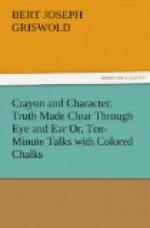TWO MEN
—Ideals
—Error
Know Your Man Before You Trust and Follow Him—Our Ideals.
THE LESSON—That we cannot safely choose an example of true living from among those about us, without knowing their real character.
The accompanying illustration is offered for occasions in which children—especially boys—above the primary age are interested.
The Talk.
“There are a good many boys and girls who make a great mistake in trying to imitate older people; and there are a good many older people who make a great mistake when they try blindly to make a success of things just because other people have been successful in doing them. It is a splendid thing to want to have in our lives the same great governing principles which rule the lives of people who stand before us as splendid models of character; but it is not always a good thing to try to do the very same things that these people do. Why? Because it is likely that we are not cut out to do their kind of work. The Lord may have intended that we should follow an entirely different line of effort. Let us, therefore, cultivate in our own lives the great and true principles which we find in other people, but let us also try to find out what the Lord wants us to do, and then let us learn to do it just the very best we can.”
“‘Blessed is he,’ says Thomas Carlyle, ’who has found his work; let him ask no other blessing.’ The surest way to find what our life work is to be is to ‘do the common things uncommonly well.’ If we do this, our life-work will be pointed out to us clearly and plainly. Therefore, in selecting our ideals in life, let us be careful how we choose.”
[Illustration: Fig. 116]
“A boy, whom we will call John, worked in a certain downtown office. Two men used to pass the window of his place of employment very frequently. These two men were never together—in fact, they were not even acquainted with each other. Here is one of the men who passed John’s window. [Draw Fig. 116, complete.] He was evidently a laboring man, as John judged from his clothing, which showed the effects of hard work of a rather rough character. He carried a dinner bucket. John merely noticed that this man passed and repassed his window every day, but gave him very little thought. But there was another man who did attract John’s attention. Here he is: [Draw the second man, completing Fig. 117.] This second man was always well dressed, and he appeared to be a prominent business or professional man. Everything in his appearance and manner attracted the admiration of the boy. Without knowing it, John was selecting an ideal—he was studying the people whom he saw and hoping to be unlike this one and to be like that one.
[Illustration: Fig. 117]
“‘Some day,’ he said to himself, as the prosperous, well-dressed man walked by, ‘when I grow up, I hope I shall be just like him.’ He had chosen his ideal. The man was one of the leading merchants of the city, and when John found this to be so, he was still more firmly determined to pattern his life after the man whom he admired.




